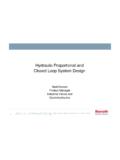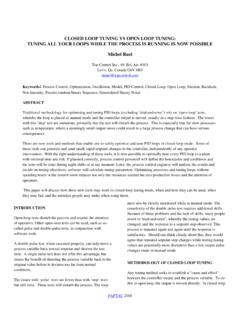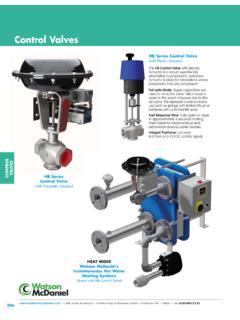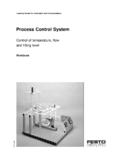Transcription of 'Seminar 800 Topic 7 - Control Loop Design' - TI.com
1 Lloyd Dixonmargin. Thus a phase lag of 117 at fc correspondsto a 63 phase 1 shows the gain -phase plots of two aver-age current mode Control loops and their transientresponse to a step change in load current. Bothloops cross over at 10 plots are simplified gain -phase plots thatare convenient for depicting the frequency charac-teristics of a feedback 1 POLE loop has one active pole from 10 Hzto over lookHz. Thus the phase lag atfc is 90 andthe phase margin is also 90 . Note that with the -1slope associated with a single pole, the gain doesnot rise rapidly at lower frequencies.
2 The lowerSummary:This paper surveys many practical aspects ofcontrol circuit design . topics include: differentapproaches for achieving Nyquist stability criteria,transient response vs. phase margin, low frequencyaccuracy vs. the shape of the Bode plot, why it isdangerous to depend on conditional stability,achieving the maximum crossover frequency of aswitched loop., other factors which may limit loopbandwidth, sources of error, and where to place thegain needed for practical aspects include large signalbehavior and how to minimize offset error delays ofcompensation capacitors in the feedback Loop BasicsThe Control loop in a high perfonnance switchingpower supply requires high gain, to achieve goodregulation, and high bandwidth, to achieve rapidresponse to sudden changes of line or loop gain inevitably declines at highfrequency, limiting bandwidth.
3 The frequency atwhich the loop gain crosses through 1 (OdB) isdefined as the crossover frequency,fc. The declin-ing loop gain at high frequency is accompanied byphase lag (in addition to the nonnal 180 phaseshift associated with negative feedback). Theamount of additional phase lag is a function of howrapidly the gain drops with frequency. According toNyquist' stability criteria, the loop will be unstableif the additional phase lag exceeds 180 at thecrossover the excess phase lag atfc is very close to the180 limit, the loop will be stable but the transientresponse will exhibit under-damped oscillations(ringing).
4 A clean transient response requiresconsiderably less than 180 excess phase lag amount less than 180 is referred to as phaseFig. 1 -Gain -Phase Plot and Transient ResponseControl Loop Designgain/bandwidth will hurt power supply characteris-tics such as regulation and audio also that the transient response is slower. Thearea between the [LOAD step change and the 1 POLE response curve represents a charge deficit inthe output capacitor that is never made up, exceptby the output voltage ultimately sagging and callingfor more current,In the 2 POLE loop, if the two poles were activethrough and well abovefc (IOkHz), the phase lag atfc would approach 180 -almost zero phase transient response would exhibit severe the 2 poles are not active above SkHz.]
5 A zeroin the Control amplifier causes a -2 to -1 slopetransition at fc/2, This results in 117 phase lag, ora phase margin of 63 , Below SkHz (fc/2), the -2slope causes the gain to rise rapidly at lowerfrequencies, optimizing gain-bandwidth, With the-1/-2 zero transition at fc!2, transient response iscritically damped-see Figure 1. The initial chargedeficit is not only smaller, the slight overshootcompensates precisely for the initial deficit. This ischaracteristic of a critically damped frequencies well below the zero atfc!2, phaselag does approach 1800 , and the phase marginvanishes.
6 This is desirable because it is associatedwith the -2 slope which rises rapidly at lowerfrequencies, improving gain-bandwidth. 180 phaselag is also acceptable. Adequate phase margin isrequired only at fc. The circuit will not misbehavewith 180 phase lag at frequencies below fc , as longas there is adequate phase margin at fc .Two poles are shown occurring near 10Hz: thepower circuit inductance with its series resistance,and the Control circuit operational amplifier reach-ing its gain limit. Loop gain flattens out, and excessphase lag diminishes toward 0 .Conditional Stability: The criteria for loopstability pennits the phase shift to actually exceed180 (negative phase margin) at frequencies belowfc.
7 This is called "conditional" stability because itdepends upon the strict requirement that the phaseshift be 1800 (preferably much less) at the unitygain crossover frequency. Thus, the 180 limitationapplies only at fc where the gain is 1, not at anylower frequency even though the gain may be is usually not wise to depend upon conditionalstability. Under conditions such as startup or largerapid load changes, operational amplifiers in theloop may be driven "into the stops". This is equiva-lent to a temporary reduction in loop gain andcrossover frequency. If phase shift exceeds 1800 atthe temporarily lower fc, the circuit will likelycommence a large signal oscillation from which itcannot recover.
8 In summary , the gain characteristic should havea -I ( I pole) slope as it traverses the unity gaincrossover frequency. A zero at fc/2 will result in a-2 (2 pole) slope at lower frequencies. This willprovide optimum bandwidth and critically dampedtransient response. The phase lag approaches 180 at lower frequencies, but this is quite , it is unwise to go beyond 180 anddepend on conditional stability .With inadequate phase margin, the ringing fre-quency will be at or near frequency: The unity gain crossoverfrequency,fc, is usually the best starting point foroptimum Control loop design , working back towardlower frequencies to obtain the best possible , fc of a linear closed loop systemcould be at any frequency, provided the criteria foradequate phase margin are fulfilled.
9 In practice, itbecomes necessary to cross over the linear systemwhen cumulative phase shifts of various loopcomponents become too great to compensate. Thisproblem is compounded when gain and phase shiftof various loop elements change, sometimes unpre-dictably, due to tolerances and temperature power supplies Control loops haveadditional complications that can limitfc. The righthalf-plane zero encountered in the output of contin-uous mode boost and flyback topologies is not onlynear-impossible to compensate, it moves in frequen-cy as a function of load. With voltage mode con-trol, loop gain varies as a function of input discontinuous operation or with current modecontrol, voltage loop gain varies with load.
10 All ofthis can make it extremely difficult to achieve ahighfc while adhering to Nyquist' stability criteriaunder all conditions of reason current mode Control can providebetter Control loop performance is that the current7-2 UNITRODE CORPORATIONC ontrol Loop design ExamplesDefinitions:Rt: "transresistance"-the translation of inductorcurrent to a voltage, Vi' In its simplest form,Rt = current sense resistor Rs. With a currenttransformer, Rt = Sawtooth voltage, peak-peakIs Switching frequencyIci Current loop crossover frequencyIcv Voltage loop crossover frequencyloop and the outer voltage Control loop are bothsimplified, making it much easier to achieve highcrossover frequency in both loops .

















